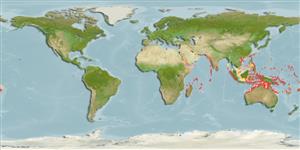>
Eupercaria/misc (Various families in series Eupercaria) >
Haemulidae (Grunts) > Plectorhinchinae
Etymology: Plectorhinchus: Greek, plektos = plaited + Greek, rhyngchos = snout (Ref. 45335).
More on author: Günther.
Environment: milieu / climate zone / depth range / distribution range
Ökologie
seewasser riff-verbunden; tiefenbereich 2 - 50 m (Ref. 9710). Tropical; 30°N - 23°S
Indo-Pacific: Red Sea to Fiji, north to southern Japan (Ref. 9710), south to Australia and New Caledonia (Ref. 9710); throughout Micronesia.
Size / Gewicht / Alter
Maturity: Lm ? range ? - ? cm
Max length : 100.0 cm TL Männchen/unbestimmt; (Ref. 9710); max. veröff. Gewicht: 15.0 kg (Ref. 9710)
Rückenflossenstacheln (insgesamt) : 12 - 13; Rückenflossenweichstrahlen (insgesamt) : 17 - 20; Afterflossenstacheln: 3; Afterflossenweichstrahlen: 7.
Occurs along outer reef slopes. Adults usually solitary but may occur in pairs. Juveniles in shallow turbid coastal areas (Ref. 9710).
Life cycle and mating behavior
Geschlechtsreife | Fortpflanzung | Ablaichen | Eier | Fecundity | Larven
Oviparous, distinct pairing during breeding (Ref. 205).
Myers, R.F., 1991. Micronesian reef fishes. Second Ed. Coral Graphics, Barrigada, Guam. 298 p. (Ref. 1602)
IUCN Rote Liste Status (Ref. 130435: Version 2024-2)
Bedrohung für Menschen
Harmless
Nutzung durch Menschen
Tools
Zusatzinformationen
Download XML
Internet Quellen
Estimates based on models
Preferred temperature (Ref.
123201): 26.1 - 28.9, mean 27.8 °C (based on 532 cells).
Phylogenetic diversity index (Ref.
82804): PD
50 = 0.5000 [Uniqueness, from 0.5 = low to 2.0 = high].
Bayesian length-weight: a=0.01660 (0.01061 - 0.02596), b=2.98 (2.85 - 3.11), in cm total length, based on LWR estimates for this species & Genus-body shape (Ref.
93245).
Trophic level (Ref.
69278): 3.5 ±0.4 se; based on diet studies.
Widerstandsfähigkeit (Ref.
120179): sehr niedrig, Verdopplung der Population dauert mehr als 14 Jahre. (Preliminary K or Fecundity.).
Fishing Vulnerability (Ref.
59153): High vulnerability (60 of 100).
Nutrients (Ref.
124155): Calcium = 21.4 [8.5, 39.5] mg/100g; Iron = 0.447 [0.238, 0.842] mg/100g; Protein = 19.3 [17.5, 21.2] %; Omega3 = 0.11 [0.06, 0.18] g/100g; Selenium = 40.9 [23.1, 68.7] μg/100g; VitaminA = 55 [21, 140] μg/100g; Zinc = 0.978 [0.689, 1.399] mg/100g (wet weight);
